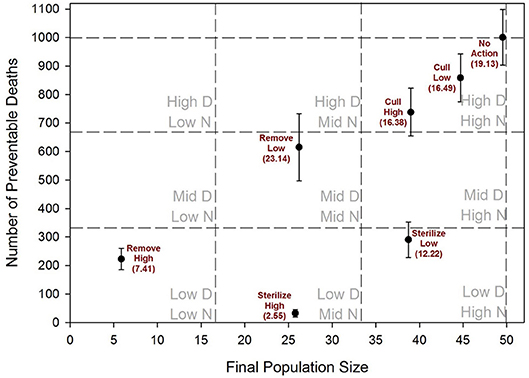Usually when CPSG gets asked to help model a species’ population, it’s shrinking. This time, CPSG helped model a population whose growth is the problem for wildlife: feral cats. In the United States alone tens of millions of feral cats prey on birds and other wildlife. In a newly published study, co-author and CPSG Senior Program Officer Phil Miller helped develop a model to determine how feral cat populations could respond to different strategies to reduce their growth and harmful impact on wildlife.
The study found that a method of contraception called trap-neuter-return, or TNR, can reduce cat suffering while also reducing the size of the feral population over time. Through TNR, feral cats are humanely trapped, spayed or neutered, vaccinated against disease, and returned to their communities. The fixed cats no longer reproduce, and the population of feral cats declines over time. Cat suffering is also reduced because many kittens that would have died before reaching adulthood are never born in the first place

Credit: Boone JD, Miller PS, Briggs JR, Benka VAW, Lawler DF, Slater M, Levy JK and Zawistowski S (2019) A Long-Term Lens: Cumulative Impacts of Free-Roaming Cat Management Strategy and Intensity on Preventable Cat Mortalities. Front. Vet. Sci. 6:238. doi: 10.3389/fvets.2019.00238
Removing feral cats from the environment – followed by adoption for some and euthanasia for others – is the most effective method for reducing feral numbers. As always, spaying or neutering pet cats and keeping them indoors is another valuable method for keeping feral cat populations at more manageable levels.
This most recent study is part of a larger effort to learn how best to manage feral cat populations, taking into account the many different angles from which the problem could be approached, including wildlife conservation, veterinary medicine, and cat welfare. Follow-up studies are planned to examine feral cat management from biological and economic perspectives. This work also has implications for potential ways to manage threats to wildlife from other exotic predators.
The Alliance for Contraception in Cats & Dogs (ACC&D) coordinated the study with funding from the American Society for the Prevention of Cruelty to Animals (ASPCA). In addition to these two organizations, other participating authors of the study are from the Great Basin Bird Observatory, Illinois State Museum; and the University of Florida College of Veterinary Medicine.
Photo Credit: Steve Baker [CC BY-ND 2.0 (https://creativecommons.org/licenses/by-nd/2.0/)]


